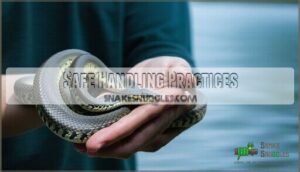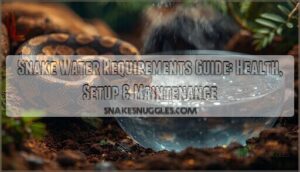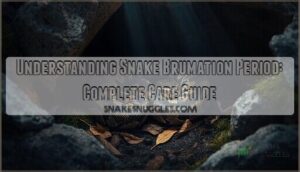This site is supported by our readers. We may earn a commission, at no cost to you, if you purchase through links.

This waiting period allows your snake’s system to properly process its meal without interference. Smaller snakes or those fed smaller prey may be ready sooner, while larger snakes or bigger meals require the full 72-hour window.
Temperature also affects digestion speed – cooler environments slow the process. Watch for signs like a visible bulge in your snake’s body, which indicates the meal hasn’t fully digested yet.
Understanding your snake’s specific needs and recognizing the subtle signs of readiness can make all the difference in successful handling, as it helps prevent digestive stress and ensures a safe interaction with your snake.
Table Of Contents
- Key Takeaways
- Handling After Feeding
- How Long to Wait After Feeding
- Feeding and Handling Techniques
- Post-Feeding Handling Considerations
- Optimal Handling Times and Schedules
- Frequently Asked Questions (FAQs)
- Can I hold my snake 24 hours after feeding Reddit?
- How long should I wait after feeding my baby?
- What signs indicate animal stress during handling?
- How does feeding size affect handling timing?
- Can different species be handled together safely?
- What temperature conditions affect post-feeding handling?
- How often should handling equipment be cleaned?
- Conclusion
Key Takeaways
- You’ll need to wait at least 48-72 hours after feeding before handling your snake to prevent regurgitation and digestive stress.
- Larger meals and cooler temperatures require longer waiting periods, while smaller prey and warmer environments may reduce the necessary wait time.
- You can tell if your snake’s ready for handling by checking for visible food bulges in their body and observing normal, active movement patterns.
- Never rush the handling timeline as premature contact can cause serious health complications including defensive strikes and dehydration.
Handling After Feeding
You shouldn’t handle your snake for at least 48-72 hours after feeding to prevent regurgitation and stress.
This waiting period allows proper digestion and keeps both you and your snake safe during interactions.
General Guidelines for Handling
After feeding your snake, you must wait at least 48 hours before handling to prevent regurgitation and stress.
This essential safety protocol allows proper digestion and reduces health risks.
Young snakes may tolerate shorter intervals, but adults need the full waiting period.
Always follow feeding schedules and handling techniques that prioritize your snake’s wellbeing and safety.
It’s vital to take into account the snake’s digestion time frames when determining the best handling approach to ensure proper digestion and minimize health risks.
Factors Affecting Handling Time
Several key factors determine how long you’ll wait before handling your snake after feeding.
Meal size substantially impacts handling delays – larger prey requires 48-72 hours while smaller meals need only 24-48 hours.
Temperature affects digestion speed dramatically; cooler environments extend safe handling times.
Animal stress from environmental changes or illness increases waiting periods, making proper time management and safety protocols essential for successful feeding schedules, which rely on understanding key factors.
Safety Precautions for Handlers
Beyond timing considerations, your personal safety requires proper preparation and awareness.
Handler Training and Safety Gear form your first line of defense against potential injuries during post-feeding interactions.
- Wear protective gloves and long sleeves to prevent defensive bites
- Keep emergency contact numbers readily available for quick Emergency Response
- Assess your snake’s temperament through careful Hazard Assessment before each session
Effective Risk Management means recognizing that even docile snakes can become unpredictable after meals, making these Safe Food Handling Practices essential for successful handling after feeding sessions.
How Long to Wait After Feeding
You need to wait at least 48 hours after feeding your snake before handling to prevent regurgitation and stress.
This waiting period allows proper digestion and reduces health risks substantially.
Feeding intervals depend on your snake’s age, size, and species, with larger meals requiring extended wait times.
Post feed care involves monitoring for signs of distress and maintaining ideal environmental conditions.
Here are key considerations for safe handling delays:
- Temperature matters – cooler environments slow digestion, requiring longer wait times
- Size counts – larger prey items need up to 72 hours before safe handling
- Watch for bulges – visible food lumps indicate ongoing digestion processes
- Monitor behavior – active movement suggests readiness for gentle interaction
- Keep records – tracking feeding schedules helps prevent accidental early handling
Following proper food safety guidelines protects your snake from regurgitation, aspiration, and digestive complications.
Baby snakes often need conservative handling delays due to their sensitive digestive systems.
Safe food handling practices include maintaining quiet environments and avoiding abdominal pressure during the critical post-feeding window.
Feeding and Handling Techniques
You’ll need proper techniques to feed and handle your snake without causing stress or health problems. These methods guarantee your snake stays healthy while keeping you safe during every interaction.
Proper Feeding Methods
You’ll want to match your snake’s specific dietary requirements with high-quality prey items sized appropriately for their species and age.
Fresh, clean water should accompany every meal, while proper Food Quality guarantees healthy Nutrient Balance for healthy growth.
Establish consistent Meal Frequency using reliable Feeding Tools to maintain safe feeding practices and support your snake’s digestive health effectively.
Utilizing proper snake feeding tools is vital for a healthy snake.
Safe Handling Practices
When handling your snake, you must prioritize Handler Safety and Animal Welfare above all else.
Support your snake’s body at multiple points, never grab just the head or tail. Move slowly and confidently – sudden movements stress both you and your pet.
Proper Handling Techniques include washing hands before and after contact, ensuring secure grip, and maintaining calm body language throughout interactions.
Using proper snake handling gloves is essential for protecting yourself from potential bites.
Common Mistakes to Avoid
Rushing to handle your snake immediately after feeding tops the list of Care Mistakes that can trigger Animal Stress.
Never grab your pet within 48-72 hours post-meal, as this creates serious Handling Risks including regurgitation and defensive strikes.
These Feeding Errors mirror newborn feeding schedule disruptions – timing matters for digestive safety and reduces Safety Oversights substantially.
Understanding proper snake feeding techniques is vital to prevent such mistakes and guarantee the overall health of your pet.
Post-Feeding Handling Considerations
After feeding your snake, you’ll need to take into account several important factors that affect when it’s safe to handle them again.
These considerations include potential health risks, environmental conditions, and the proper equipment needed for safe post-feeding interactions, which are crucial for safe handling.
Health Implications of Handling
Mishandling your snake after feeding can trigger serious health complications that you’ll want to avoid. Proper timing protects both you and your pet from unnecessary risks.
Understanding the risks of nutritional deficiencies, such as those related to electrolyte imbalance, is essential for maintaining your snake’s health.
Key Health Implications:
- Handling Risks increase when snakes regurgitate, leading to dehydration and nutritional deficiencies
- Disease Transmission occurs through contaminated surfaces, affecting both handler and snake health
- Injury Prevention requires waiting periods to avoid defensive bites from stressed, digesting snakes
- Stress Management becomes critical as premature handling disrupts natural digestive processes and weakens immunity
Environmental Factors to Consider
Several environmental factors substantially impact your snake’s post-feeding comfort and safety.
Temperature Control maintains proper digestion, while Humidity Levels prevent respiratory issues. Air Quality and Noise Reduction create calm conditions essential for recovery.
| Environmental Factor | Impact on Post-Feeding Snake |
|---|---|
| Temperature fluctuations | Disrupts digestion, causes regurgitation |
| Low humidity | Creates respiratory stress, dehydration |
| Poor air circulation | Increases bacterial growth, illness risk |
| Loud noises/vibrations | Triggers stress response, digestive problems |
Monitor these conditions closely—your snake’s vulnerable state requires stable surroundings for successful meal processing.
Handling Equipment and Tools
What tools enhance your post-feeding handling safety? You’ll need snake hooks for maintaining distance, secure transport containers for movement, and properly calibrated scales for monitoring weight changes.
Equipment safety requires regular tool maintenance and thorough operator training in safe baby handling techniques.
Essential feeding and handling gear includes headlamps, thick gloves, and escape-proof enclosures that support effective baby handling techniques while ensuring food handling precautions remain paramount.
Understanding the snake’s digestion time factors is vital for determining the ideal handling schedule to prevent regurgitation and stress.
Optimal Handling Times and Schedules
You’ll need to establish a consistent handling schedule that works with your snake’s feeding routine and your own availability.
Regular timing helps your snake adapt to handling while ensuring proper digestion occurs between meals, which is crucial for the snake’s health.
Creating a Handling Schedule
You’ll want to establish consistent handling intervals that align with your snake’s feeding cycles.
Log each feeding and handling session to identify patterns that work best for your pet. Schedule flexibility becomes important during growth spurts or seasonal changes when your snake’s metabolism shifts.
Proper time management helps you’re never rushing the process, which reduces stress for both you and your snake.
Understanding the vital snake feeding schedule is essential, and following a proper feeding routine helps maintain your snake’s health and well-being.
Flexibility in Handling Times
While creating a structured schedule helps establish routine, you’ll need flexibility in your handling times.
Your snake’s individual needs and unexpected circumstances will require adjustments to your planned handling windows.
Adaptive handling means staying responsive to your pet’s signals and environmental changes.
Here’s what flexible handling looks like:
- Stress-free adjustments when your snake shows feeding behavior longer than expected
- Weather-responsive timing during temperature fluctuations that affect digestion
- Health-conscious delays if you notice unusual behavior or sluggish movement
- Life-balance flexibility when your schedule conflicts with ideal handling windows
- Growth-adaptive intervals as your snake’s metabolism changes with age.
Variable intervals work better than rigid schedules because snakes aren’t clockwork creatures.
Baby snakes might need different time frames than adults, and feeding safety tips always emphasize watching individual responses over following strict timelines.
Your handling approach should bend like a reed in the wind—strong enough to maintain safety standards but flexible enough to accommodate real-life situations.
Monitoring and Adjusting Handling Times
While flexibility keeps your approach adaptable, monitoring your snake’s responses helps you fine-tune handling protocols for ideal animal welfare.
Track your pet’s behavior patterns after feeding to establish personalized handling intervals that work best.
Proper snake handling requires suitable handling safety gear.
| Time After Feeding | Snake’s Typical Response | Recommended Action |
|---|---|---|
| 24-48 hours | Sluggish, defensive posturing | Avoid handling completely |
| 3-5 days | Mild stress signs when touched | Light observation only |
| 7+ days | Normal alertness and movement | Safe for regular handling |
Your time management approach should evolve based on these observations.
Baby snakes require modified feed schedules and gentler handling newborns safely protocols, while adults follow standard feeding safety tips and handling guides.
Frequently Asked Questions (FAQs)
Can I hold my snake 24 hours after feeding Reddit?
While patience tests your resolve, you can’t safely handle your snake just 24 hours after feeding. Wait at least 48-72 hours to prevent regurgitation and stress-related health issues.
How long should I wait after feeding my baby?
You should wait at least 30 minutes before handling your baby after feeding. This allows proper digestion and reduces spit-up risk. Watch for signs they’re comfortable and content first.
What signs indicate animal stress during handling?
Animals show stress through rapid breathing, excessive vocalization, trembling, rigid posture, dilated pupils, and attempts to escape.
You’ll notice increased heart rate, panting, drooling, or aggressive behaviors when they’re overwhelmed during handling sessions, which can include excessive vocalization.
How does feeding size affect handling timing?
Larger meals require longer digestion periods before you can safely handle animals.
You’ll need to wait 24-48 hours after big feedings versus 12-24 hours for smaller portions to prevent regurgitation and stress.
Can different species be handled together safely?
Mixing different species is like playing with fire—you’re asking for trouble.
Don’t house different snake species together, as they can carry species-specific diseases and parasites that cross-contaminate, plus territorial stress often leads to aggression.
What temperature conditions affect post-feeding handling?
Temperature extremes substantially impact post-feeding handling safety.
You’ll need to wait longer in cooler conditions since digestion slows, while warmer temperatures accelerate metabolism, potentially reducing necessary waiting periods before safe handling.
How often should handling equipment be cleaned?
Like clockwork from yesteryear’s laboratory protocols, you’ll want to clean your handling equipment after every feeding session.
This prevents bacterial buildup and cross-contamination between animals, ensuring their health and safety remain your top priority.
Conclusion
Surprisingly, your snake won’t file a complaint with customer service if you handle it too soon after feeding, but you’ll definitely regret ignoring the waiting period.
Proper timing for how long after feeding to handle your snake depends on multiple factors including species size, meal type, and environmental conditions.
You’ll typically wait 48-72 hours before handling, though smaller snakes may be ready sooner.
Remember to monitor your snake’s body for visible bulges and maintain appropriate temperatures to support healthy digestion throughout this sensitive period.
- https://www.mountsinai.org/health-library/selfcare-instructions/spitting-up-self-care
- https://www.reddit.com/r/beyondthebump/comments/17u0s9s/do_you_keep_your_baby_upright/
- https://kidshealth.org/en/parents/burping.html
- https://www.mysanitas.com/en/blog/baby-feeding-charts-see-what-our-pediatricians-recommend
- https://www.mayoclinic.org/healthy-lifestyle/infant-and-toddler-health/in-depth/healthy-baby/art-20047741











